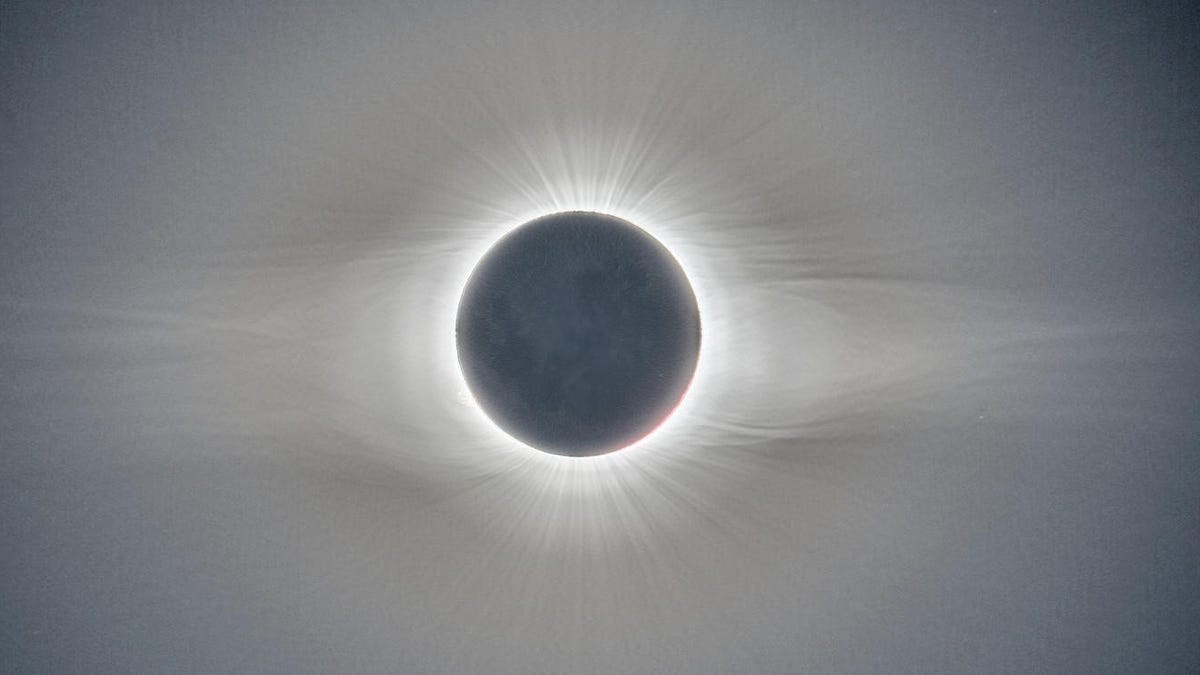See the 2019 solar eclipse from Earth, orbit and even the moon
A total solar eclipse swept across the Pacific Ocean, Chile and Argentina in stunning fashion.
A rare celestial phenomenon triggered awe on Tuesday when the moon stepped in front of the sun during a total solar eclipse across the Pacific Ocean and a sliver of South America.
Only a small portion of land in Chile and Argentina lay in the path of the total eclipse, but the world was able to watch along through live feeds from observatories in Chile. The European Space Agency combined multiple exposures during totality (when the moon completely covers the sun) to get a view of the sun's halo-like corona.
The solar eclipse wasn't just visible from the ocean and on land. Chinese lunar orbiter DSLWP-B snapped one of the wildest views of the eclipse. The shot shows the moon with the Earth in the distance, a dark splotch marking the moon's shadow on the planet.
This image of the #SolarEclipse2019 was taken yesterday by the Chinese lunar satellite DSLWP-B, and downloaded just now with telescopes in Dwingeloo and Bejing. Command upload by @KuehnReinhard; planning by @bg2bhc and @ea4gpz. https://t.co/LYSMUCCwGX
— Dwingeloo Telescoop (@radiotelescoop) July 3, 2019
Another unusual space perspective came to us from ESA's Proba-2 satellite, which witnessed four partial eclipses from its vantage point in orbit.
The space images were spectacular, but lucky viewers in the path of totality experienced the shadow in person. Astronomer and photographer Matt Robinson traveled to Chile with his camera at the ready. "I cannot believe what I have just witnessed!" he wrote on Twitter.
Photographer Matt Robinson captured this beautiful view of the eclipse in Chile.
Ian Griffin, director of the Otago Museum in New Zealand, ventured out on a boat to experience the eclipse from the middle of the ocean. While it was rainy and cloudy out there, he captured what it felt like to plunge into darkness in a time-lapse video he posted to Twitter .
Near Oeno in the middle of the pacific I have just witnessed a solar eclipse @OtagoMuseum https://t.co/Y7CRUCTVzj
— Ian Griffin (@iangriffin) July 2, 2019
The National Oceanic and Atmospheric Administration's GOES weather satellites got a great view of the moon's shadow making its way across the globe. This image show both the shadow and Hurricane Barbara.
NOAA's GOES West satellite saw both the moon's shadow and Hurricane Barbara in the Pacific.
NOAA tweeted a GIF of the shadow in motion.
In this view from #GOESWest, you can see the moon's shadow over the Pacific Ocean as the #TotalSolarEclipse makes its way toward South America. More imagery: https://t.co/aHnIqKeF9t pic.twitter.com/8zuupZOXV1
— NOAA Satellites (@NOAASatellites) July 2, 2019
The European Space Agency shared a view on Twitter of the "diamond-ring effect" just before totality. It gets the name from the gem-like splash of light the emanates from the side of the eclipse.
Wow! We loved this view of the 'diamond ring' effect just before totality 💍
— ESA Science (@esascience) July 2, 2019
Continue watching the #solareclipse here - about an hour to go -> https://t.co/goRI4bTL2X #eclipse2019 #solareclipse #TotalEclipse pic.twitter.com/TFQwc0iMAd
Tuesday's total solar eclipse was the first since 2017's great American eclipse.
You'll need to wait until Dec. 14, 2020, for the next time the moon completely smothers out the sunlight. That eclipse will also track across lower South America. Chile and Argentina are just lucky countries when it comes to winning the total solar eclipse lottery.
Originally published July 2.
Update July 3: Adds more eclipse images.


